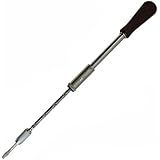Anyone got any tips on how to remove rounded screws? Decorating the bathroom and the 4 of the door handle screws have very rounded screws.
Cheers.
If you have a dremel you can cut a channel in them to use a flat head. Alternatively use the screwdriver as a punch and hit it with a hammer to make a new mark. These might be a bit drastic mind you.
Crosshead or Pozi I assume?
I've had some success with a thin flatblade screwdriver with sharp corners on rounded screws but it has to be a VERY tight fit. Same with a Torx driver (might ruin the torx head though so don't use expensive ones!
Pressure on the screwdriver forcing it into the screw head is more important than twisting force too.
Last option would be to drill the heads off carefully leaving as much screw body as possible, remove the handle and use pliers / molegrips to turn the body of the screw.
Good luck.
Si
cut a slot and use a flat screwdriver. Two hacksaw blades in a handle makes a wider slot thats easier to get a big screwdriver in.
Nothingis better for teasing out a hundred year old screw than a fully extended 18" Yankee
Ooh you saucy devil.
Those screw extractors work well mostly. They're less good (IME) if the screws are stainless steel but otherwise they should do the trick.
Thanks so much! Torx head worked!
Good news!
Si
How does the length of the screwdriver affect torque?
How does the length of the screwdriver affect torque?
It doesn't (as far as I am aware - I'm sure someone who understands the maths'll be along in a minute with a clever opinion)
What a long screwdriver does do is allow you more precise control over the application of the torque without the screwdriver slipping.
Again, I don't understand the maths that makes that work, but it does.
Small hand movements have less effect on angle relative to the screw.
Its easier to keep straightand nit have the driver slip out the screwhead.
I've had success on stuff that you can access the other side of (like a door) by taking a screwdriver bit, clamping it into place with a small sash clamp and then turning the bit with an appropriate spanner.
No idea if it actually works successfully, but I saw a video on YouTube where you stick a piece of rubber (e.g. rubber band) between the bit and the screw head - gives enough friction to help grip and budge it.
I had a couple of rotor bolts that wouldn't budge a while back, tried filing across them to use a flat bladed screwdriver but no dice - ended up using an old drill bit slightly smaller than the bolt with the drill set in reverse & leaned on it heavily while giving it full beans - even though it doesn't technically have anything to grip on, the heat generated by the friction of the drill bit was enough to break the bond between the screw & thread and it popped out cleanly.
I then of course burnt my damn hand on the bolt as it picked it up to examine what had happened, the top of the bolt had a perfectly smooth concave in it from the hardened drill bit, even in reverse - still have it somewhere as a reminder to use anti-seize on bolts.
If the screws are flats take extra care if trying this, a cross head / hex helps to keep the bit centered when you're pushing against it, also if this wrecks the screw heads completely & leaves you in a worse situation don't blame me - it was you who put your faith in some bloke off the tinternet


